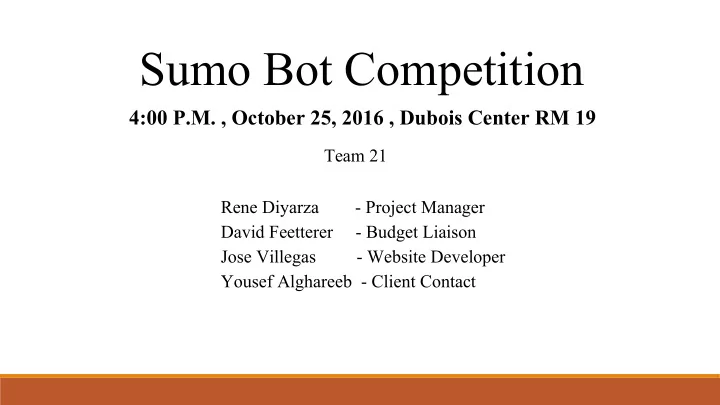

Sumo Bot Competition 4:00 P.M. , October 25, 2016 , Dubois Center RM 19 Team 21 Rene Diyarza - Project Manager David Feetterer - Budget Liaison Jose Villegas - Website Developer Yousef Alghareeb - Client Contact
Project Description Four different types of robots must be design for four different types of competition. Two robots compete in a head-to-head match following the basic system of traditional human sumo matches. NAU is our primary sponsor financially and managerially Showcase our skills obtained from the undergraduate program at NAU 1 JV
Design Considered (Autonomous) Figure 1: Treads Figure 2: 4 Tires Figure 3: 2 Tires A:Does not need recharge. A:Produce more speed. A:Better weight distribution. D:Weight is not distributed evenly. D:Harder to build. D:Less traction. 2 YA
Design Selected (Autonomous) -Tires are more durable, requires less torque, and produce more traction than treads. - Infrared sensor is cheaper than ultrasonic detectors and more accurate and more accurate. -Battery is the most reasonable choice for the autonomous robot. Figure 4: Selected Design 3 YA
Design Considered (RC) Figure 7: SpinnerBot Figure 5: BumperBot Figure 6: Charging Controller A: Controlled A: No need for A: Spherical impact outlet D: Focused more D: Unbalanced D: Bulky on remote than 4 JV robot
Design Selected (RC) - The biodesign showed to succeed over the others - Bumpers targets impact - Adjustable bumpers for any competitor - Smaller front wheels for balance 5 JV Figure 8: Selected Design
Design Considered (Nano) Figure 9, Defensive kicker Figure 10, Bio Inspired Figure 11, Uni-body SumoBot Preliminary Design Preliminary Design Preliminary Design A: Defense A: Resist pushing from Opponent A: Simple, High Maneuverability, D: Increased weight, Minimal D: Manufacturability, Increased Various Centroid Location interior Weight D: Low Profile-easy to tip, minimal 7 DF interior
Design Selected (Nano) Advantages: Resist Opponent, High Maneuverability, One Structure (i.e. better response to applied forces), Large area to house and protect electronics. Disadvantages: Increased Weight, High Center of Gravity, Large Stress concentrators 6 DF Figure 12: Preliminary Bio-Inspired Design
Design Considered (Bartending) Figure 14: Clamp Figure 13: Dispensor Figure 15: Carousel A: No room for error A: Movement/Appealing A: Variety of drinks D: Not appealing D: Coding (Precision) D: More weight 8 RD
Design Selected (Bartending) - Has the capability to firmly grasp the bottle or container - Multitude of angles - Can be more precise than other designs (Controlled) - Catches the attention of the audience Figure 16: Clamp with Base 9 RD
Schedule Figure 17: Gantt chart 10 RD
Budget Project’s budget ○ Provided: $ 1000 ○ Prospective Sponsors: Mother Road, Lumberyard, Hops On Birch, SAE Anticipated expenses ○ Entry Fees: $ 190 ○ Electronics (Microcontrollers, Motors, Sensors, Batteries, ESC, Power Transmission): $ 200/robot ○ Building Materials: $ 80 Remaining Balance: $1000 11 DF
Questions and Answers
Recommend
More recommend